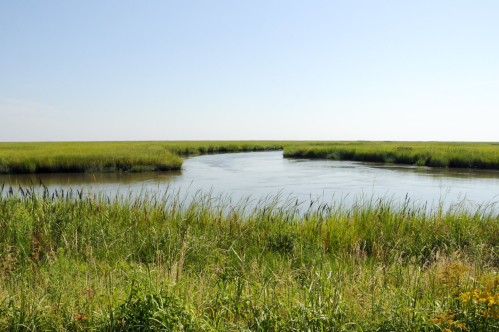If you are into bugs then you may be familiar with InsectIdentification.org which is a site that lists species of insects, arachnids, and other creepy crawlies by state. After doing the research, we have found that there are more than 300 well-documented species of "bugs" (a term we will use to include anything that crawls around and isn't obviously a mammal) in Virginia. However, entomologists and researchers estimate more than 20,000 species of bugs and bug-like creatures that call Virginia home. That's a LOT of bugs. Obviously, we are not going to list them all here. Instead, we're going to show you a few that we find particularly disturbing...and a few that you may not be familiar with. If you consider yourself a casual observer of insects or you just want to know which ones to stay away from, here are 15 weird bugs in Virginia. So here goes...enjoy!
1. A Wolf Spider with an Egg Sac
This lovely lady was photographed in Dyke Marsh and was close to 2-3" in width. The Wolf Spider of Virginia is actually called the "Carolina Wolf Spider" and is the largest of its kind in North America. Although the only threat they present to humans is that they may make your heart stop beating if you encounter one unexpectedly, they hunt their prey by waiting at the mouth of their burrow by day or in active hunting "expeditions" at night. Wolf Spiders' mating season starts in the spring and they are attracted to vibrations. Then the male will dance to woo his potential mate which will either win her over or if she is uninterested she will just eat him. Life as a wolf spider is pretty rough. And a word to the wise, you might want to keep the Barry White CDs to a minimum as these bad boys tend to wander inside during mating season.
2. Grasshopper…or Apple-hopper in this case
Photographed in Markham, this Differential Grasshopper seemed rather attached to his apple. These "little" fellows grow to be nearly 2" long, so even with their brownish-yellow coloring, they don't always blend into the woodwork. Interestingly enough the grasshopper is a very solitary creature and will mostly keep to themselves. However, if they bump into each other too many times then a chemical is released and they change color and become one cohesive swarm. This change allowed them to fly and work together and the term grasshopper goes out the window because they are now locust. These swarms can become very destructive and can grow and create chaos of biblical proportions.
3. Daddy Longlegs…LOTS of Daddy Longlegs
Despite their cute name, these creepy crawlies are just….well, creepy. Also known as Harvestmen, they are completely harmless to humans. Speaking of which, it's time to dispel a rumor about these long-legged bugs. It's been commonly cited that they are the most venomous insects around, but that their mouths are too small to bite humans. In fact, none of the known species - and there are more than 6,500 worldwide - are venomous. Instead of fangs, they actually have grasping claws, but in keeping with the myth, those are, in fact, too weak to break human skin. So we're safe. For now.
Wait. Daddy Longlegs don't creep you out? Oh. Ok, here's a close up.
Most people view daddy longlegs as a "safe" spider and it doesn't creep them out much and from a distance, a Daddy Longlegs might not be so bad…but this? No thanks.
4. WHAT?!!
We've tried to identify this one…but we can't seem to find it anywhere! Do any bug experts out there know what this is? These guys creep us out beyond belief. we're hoping they're called "The Great North American Care Bear Bug" or something equally soothing…anything to overcome that exterior. This photo was taken in Centreville, so this…"thing"…clearly lives in our state.
5. Earwigs
Ugh. These stealthy little bugs are known to lurk in dark, damp spaces (and that can often mean your basement) and are identified by their abdominal pincers. They are mostly nocturnal and shy, coming out to feed at night. We now realize that the last sentence just made them sound even creepier than they are..which is pretty creepy. So let's go ahead and cross every boundary and talk about their name. An old wives' tale says that they climb through the human ear canal to burrow into the brain and lay eggs. Fortunately, that doesn't seem to be a common trait of earwigs…but I'll be sleeping with earplugs just in case. You are free to sleep as normal, but if you wake up with a few hundred earwig babies in your brain then don't blame us.
6. The American Pelecinid Wasp
Although the tail looks pretty scary, it's actually not a stinger. Found on females, the Pelecinid Wasp uses it to deposit her eggs on the backs of grubs living underground. So there's that. No stinging, just underground, egg-carrying grubs. Hmmmmm.
7. The Assassin Bug
Ok, sure, it sounds like something out of a James Bond movie. But these guys are the real deal. They may be little, but they are vicious. They use their strong beaks to stab their prey to death…repeatedly…and violently..then they suck their body fluids out. And, while they are non-venomous, they can leave a pretty uncomfortable bite on humans. The photo here is of a nymph of the Wheel Bug Assassin. So, yes, it gets bigger. Good luck with that.
8. Eastern Hercules Beetle
We have to admit - we kind of like this guy. No, they are not small. Yes, they are a little intimidating. Oh, and the males have pincers on their heads and like to fight each other with them. But fear not, they are harmless to humans. As part of the Rhinoceros Beetle family, they can be found in hardwood forests in the Eastern U.S. This one was photographed at the Mattaponi Wildlife Management Area. They should be fairly easy to spot because of their size. Although their color usually tends to be a bland brownish and black, they can also have a more green body like the one in this picture.
9. Emerald Ash Borer
This bug has remarkable color, but it's a bit of a snake in the grass. Only recently added to the ever-growing list of destructive tree-killers, the Emerald Ash Borer has made its way to Virginia from its native Asia. This invasive species reproduces quickly and poses a serious threat to our state's native ash trees. Back to the color for a bit, just look carefully at the metallic and emerald green shades with a shimmering shine to it, this bug is quite fascinating. We just need to have it leave our trees alone.
10. Camel Cricket
YUCK. That's all we, personally, have to say about this creature. But given that our job is to provide actual information, we will follow up with a few facts. Fact 1: Camel Crickets are gross. Fact 2: They feed after dark. Our guess is on the hopes and dreams of unsuspecting humans, but the fact book says they're actually just after plants and maybe some other insects. Fact 3: They are known to come inside during the fall and winter, usually to basements and other low-lying areas. Fact 4: They are gross…and like other crickets, they are very, very bouncy. Fact 5: You probably shouldn't go in your basement during the fall and winter.
11. The Masked Hunter
We swear we didn't make this name up. But go figure, it's another type of assassin bug. And like the others, they can leave painful bites on humans. But wait! There's good news. The Masked Hunter usually feeds on bed bugs. So if you find them in your house…oh wait, that means you have bed bugs. Hmmm…well, you win some and you lose some.
12. Millipedes
They're harmless for the most part. We know this. You know this. But given that the females lay their eggs in piles of their own feces, they are a little gross. Add to that, some species are toxic…so, you probably shouldn't eat them. They tend to hang out in dark, damp spaces, so you're most likely to encounter them under vegetation like dead leaves in wooded areas. We will admit though watching them crawl is like seeing a crowd at a baseball game doing the wave and we find that amusing.
13. The Black Widow
Every bit as dangerous as her name sounds, the female of this species is very venomous. Identified by the red hourglass on her belly, this tricky lady isn't shy about spinning her webs in populated places…so be on the lookout. Males, on the other hand, lack venom AND the hourglass, although they also have red markings.
14. American Cockroaches
There are plenty of us who have a strong aversion to this bug. It's probably an unhealthy phobia stemming from some forgotten childhood trauma, but seriously…these are the nastiest bugs we know. However, I have been told they are harmless. As the largest cockroaches in Virginia, they are not overly common (as they are in some of the more southern states.) Not indigenous to the United States, they mostly likely came from Africa aboard cargo ships, but have thrived in humid and tropical climates in the U.S. Unfortunately if you see one in your house the general rule is there are more, like a lot more...
15. And of course, the Stinkbug
The list wouldn't be complete without these pesky little guys. They are harmless, except for the foul odor they emit when squashed -- or even just touched. But they are EVERYWHERE. The Brown Marmorated Stinkbug (Virginia's most common), was only first discovered in the Eastern United States in 1998. For a relatively recent arrival, they have flourished, invading homes in droves in the cooler months. If you've been in Virginia for the past few years, you know what I'm talking about. It is a real problem and it stinks...
If You Only Have One Day to Visit This Small Town in Maine, Here’s Everything You Absolutely Can’t Miss

If You Only Have One Day to Visit This Small Town in Massachusetts, Here’s Everything You Absolutely Can’t Miss

If You Only Have One Day to Visit This Small Town in Maryland, Here’s Everything You Absolutely Can’t Miss

So now that you all have a few more fears...we mean, bugs that we find the creepiest, tell us about yours! Clearly, this cannot be the full list of weird bugs in Virginia, so we would love to hear about a few that you find particularly bothersome in the comments below!
Speaking of bugs, do you all remember that crazy year when we had like millions of cicadas? We are still trying to get the ringing out of our ears.
Subscribe to our newsletter
Get the latest updates and news
Thank you for subscribing!
































